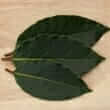Background
- Bay leaf is primarily used to flavor foods, and it is used by chefs of ethnic cuisines, from Italian to Thai. It is also frequently used in salt-free seasonings.
- Bay leaf is thought to be useful for gastric ulcers, high blood sugar, migraines, and infections. Bay leaves and berries have been used for their astringent, diaphoretic (promotes sweating), carminative (promotes digestion), digestive, and stomachic (tones and strengthens the stomach) properties. In the Middle Ages bay leaf was believed to induce abortions. Traditionally, the berries of the bay tree were used to treat furuncles. The leaf essential oil of Laurus nobilis has been used as an antiepileptic remedy in Iranian traditional medicine.
- Currently, there is not enough scientific evidence to draw any firm conclusions about the medicinal safety, effectiveness or dosing of bay leaf.
References
Natural Standard developed the above evidence-based information based on a thorough systematic review of the available scientific articles. For comprehensive information about alternative and complementary therapies on the professional level, go to . Selected references are listed below.
- Ferreira A, Proenca C, Serralheiro ML, et al. The in vitro screening for acetylcholinesterase inhibition and antioxidant activity of medicinal plants from Portugal. J Ethnopharmacol. 4-28-2006.
View Abstract - Hibasami H, Yamada Y, Moteki H, et al. Sesquiterpenes (costunolide and zaluzanin D) isolated from laurel (Laurus nobilis L.) induce cell death and morphological change indicative of apoptotic chromatin condensation in leukemia HL-60 cells. Int J Mol.Med 2003;12(2):147-151.
View Abstract - Komiya T, Yamada Y, Moteki H, et al. Hot water soluble sesquiterpenes [anhydroperoxy-costunolide and 3-oxoeudesma-1,4(15),11(13)triene-12,6alpha-olide] isolated from laurel (Laurus nobilis L.) induce cell death and morphological change indicative of apoptotic chromatin condensation in leukemia cells. Oncol.Rep. 2004;11(1):85-88.
View Abstract - Matsuda H, Shimoda H, Uemura T, et al. Preventive effect of sesquiterpenes from bay leaf on blood ethanol elevation in ethanol-loaded rat: structure requirement and suppression of gastric emptying. Bioorg.Med Chem.Lett. 9-20-1999;9(18):2647-2652.
View Abstract - Moteki H, Hibasami H, Yamada Y, et al. Specific induction of apoptosis by 1,8-cineole in two human leukemia cell lines, but not a in human stomach cancer cell line. Oncol.Rep. 2002;9(4):757-760.
View Abstract - Nayak S, Nalabothu P, Sandiford S, et al. Evaluation of wound healing activity of Allamanda cathartica. L. and Laurus nobilis. L. extracts on rats. BMC.Complement Altern Med 2006;6:12.
View Abstract - Sayyah M, Saroukhani G, Peirovi A, et al. Analgesic and anti-inflammatory activity of the leaf essential oil of Laurus nobilis Linn. Phytother Res 2003;17(7):733-736.
View Abstract - Sayyah M, Valizadeh J, Kamalinejad M. Anticonvulsant activity of the leaf essential oil of Laurus nobilis against pentylenetetrazole- and maximal electroshock-induced seizures. Phytomedicine. 2002;9(3):212-216.
View Abstract - Simic A, Sokovic MD, Ristic M, et al. The chemical composition of some Lauraceae essential oils and their antifungal activities. Phytother Res 2004;18(9):713-717.
View Abstract - Simic M, Kundakovic T, Kovacevic N. Preliminary assay on the antioxidative activity of Laurus nobilis extracts. Fitoterapia 2003;74(6):613-616.
View Abstract - Skok P. Dried bay leaf: an unusual cause of upper gastrointestinal tract hemorrhage. Endoscopy 1998;30(3):S40-S41.
View Abstract - Soylu EM, Soylu S, Kurt S. Antimicrobial activities of the essential oils of various plants against tomato late blight disease agent Phytophthora infestans. Mycopathologia 2006;161(2):119-128.
View Abstract - Tsang TK, Flais MJ, et al. Duodenal obstruction secondary to bay leaf impaction. Ann Intern Med 4-20-1999;130(8):701-702.
View Abstract - Uchiyama N, Matsunaga K, Kiuchi F, et al. Trypanocidal terpenoids from Laurus nobilis L. Chem Pharm Bull (Tokyo) 2002;50(11):1514-1516.
View Abstract - Van der Veen JE, De Graaf C, Van Dis SJ, et al. Determinants of salt use in cooked meals in The Netherlands: attitudes and practices of food preparers. Eur J Clin Nutr 1999;53(5):388-394.
View Abstract







